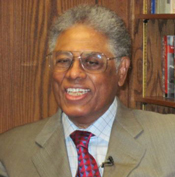Minimum Wage Madness
Weekly Editorial — Posted on November 8, 2013

Economist Thomas Sowell
(by Thomas Sowell, Townhall) – …Advocates of minimum wage laws often give themselves credit for being more “compassionate” towards “the poor.” But they seldom bother to check what are the actual consequences of such laws.
One of the simplest and most fundamental economic principles is that people tend to buy more when the price is lower and less when the price is higher. Yet advocates of minimum wage laws seem to think that the government can raise the price of labor without reducing the amount of labor that will be hired.
When you turn from economic principles to hard facts, the case against minimum wage laws is even stronger. Countries with minimum wage laws almost invariably have higher rates of unemployment than countries without minimum wage laws.

Most nations today have minimum wage laws, but they have not always had them. Unemployment rates have been very much lower in places and times when there were no minimum wage laws.
Switzerland is one of the few modern nations without a minimum wage law. In 2003, “The Economist” magazine reported: “Switzerland’s unemployment neared a five-year high of 3.9 percent in February.” In February of this year, Switzerland’s unemployment rate was 3.1 percent. A recent issue of “The Economist” showed Switzerland’s unemployment rate as 2.1 percent.
Most Americans today have never seen unemployment rates that low. However, there was a time when there was no federal minimum wage law in the United States. The last time was during the Coolidge administration, when the annual unemployment rate got as low as 1.8 percent. When Hong Kong was a British colony, it had no minimum wage law. In 1991 its unemployment rate was under 2 percent.
As for being “compassionate” toward “the poor,” this assumes that there is some enduring class of Americans who are poor in some meaningful sense, and that there is something compassionate about reducing their chances of getting a job.
Most Americans living below the government-set poverty line have a washer and/or a dryer, as well as a computer. More than 80 percent have air conditioning. More than 80 percent also have both a landline and a cell phone. Nearly all have television and a refrigerator. Most Americans living below the official poverty line also own a motor vehicle and have more living space than the average European — not Europeans in poverty, the average European.
Why then are they called “poor”? Because government bureaucrats create the official definition of poverty, and they do so in ways that provide a political rationale for the welfare state — and, not incidentally, for the bureaucrats’ own jobs.
Most people in the lower income brackets are not an enduring class. Most working people in the bottom 20 percent in income at a given time do not stay there over time. More of them end up in the top 20 percent than remain behind in the bottom 20 percent.
There is nothing mysterious about the fact that most people start off in entry level jobs that pay much less than they will earn after they get some work experience. But, when minimum wage levels are set without regard to their initial productivity, young people are disproportionately unemployed — priced out of jobs.
In European welfare states where minimum wages, and mandated job benefits to be paid for by employers, are more generous than in the United States, unemployment rates for younger workers are often 20 percent or higher, even when there is no recession.
Unemployed young people lose not only the pay they could have earned but, at least equally important, the work experience that would enable them to earn higher rates of pay later on.
Minorities, like young people, can also be priced out of jobs. In the United States, the last year in which the black unemployment rate was lower than the white unemployment rate — 1930 — was also the last year when there was no federal minimum wage law. Inflation in the 1940s raised the pay of even unskilled workers above the minimum wage set in 1938. Economically, it was the same as if there were no minimum wage law by the late 1940s.
In 1948 the unemployment rate of black 16-year-old and 17-year-old males was 9.4 percent. This was a fraction of what it would become in even the most prosperous years from 1958 on, as the minimum wage was raised repeatedly to keep up with inflation.
Some “compassion” for “the poor”!
Thomas Sowell is a senior fellow at the Hoover Institution, Stanford University and the author of “Basic Economics,” ”Applied Economics” and “The Housing Boom and Bust.” Over the past three decades, Dr. Sowell has taught economics at various colleges and universities, including Cornell, Amherst, and the University of California at Los Angeles.
Posted at Townhall.com on September 17, 2013. Reprinted here November 7, 2013 for educational purposes only.
